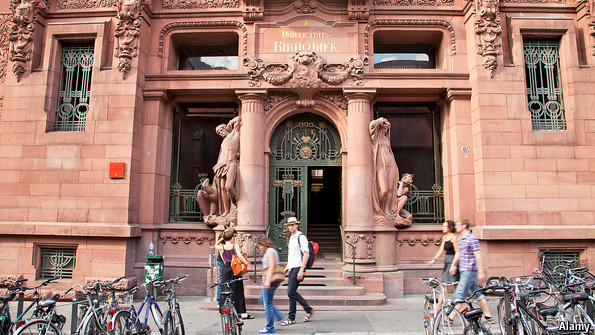Franchising, retail, business

13/12/2014
A GLANCE at the global rankings of universities suggests that nothing much has changed in recent years. MIT, Stanford, Cambridge, Oxford and a few other English-speaking campuses remain at the top, fighting it out with large endowments, celebrity professors and selective entry. By contrast, universities in Germany are nowhere near the top, even after several reforms, including an “excellence initiative” since 2005. Many students waste away in overflow rooms next to packed and stuffy lecture halls. Their best hope of seeing professors is through opera glasses.
But look more closely at the rankings, and change is more evident, thinks Günther Zupanc, a biology professor who has taught in Germany, Britain and Canada and is now at Boston’s Northeastern University. Only a couple of German universities make it into the top 50: Heidelberg’s Ruprecht-Karls-University and Munich’s Ludwig-Maximilians-University usually lead the pack. Among the top 200, however, German universities have improved the most. Taken together, they have moved up by 250 places, Mr Zupanc calculates. Only Dutch universities have done better. America’s, by contrast, have crashed: since 2011 they have collectively moved down by 692 places.
If this trend continues, Mr Zupanc suggests, it could amount to a German Mittelweg (middle path) in higher education. At one extreme of the spectrum stand the Anglo-Saxons, who breed elite universities that most students either cannot get into or cannot pay for, but do less to nurture those lower in the rankings. At the other are socialist systems which make higher education free and access easy, at the cost of less differentiation among universities and overall mediocrity.
Germany has tried both ends of this spectrum. In 1810 Wilhelm von Humboldt, a Prussian son of the enlightenment, founded the University of Berlin (now Humboldt University) on the then-revolutionary premise that professors and students should be partners in learning and that teaching and research were inseparable. His philosophy influenced university systems from America to Japan. And it led to more than a century of excellence at German universities, which for many years were the best in the world and produced thinkers from Hegel to Planck. This golden age was destroyed by the Nazis.
After 1945, West German universities revived the stuffy bits but without the excellence. Only the idolising of titles survived: even outside academia, Germans insist on being addressed with the full mouthful of “Herr Professor Doktor”. In the 1960s German students rebelled in vain. One slogan was “under the robes, the musty stink of 1,000 years”.
With the country’s first Social Democratic government in 1969, the emphasis shifted to widening access across social classes. Until a court ruling in 2005, German universities—which, like schools, are run by the states—were not allowed to charge tuition fees. Since then, seven states (all in the old West Germany) have tried, but all have given up after howls of outrage. The final holdouts, Bavaria and Lower Saxony, have recently dropped fees.
But Germany knows that higher education needs to improve. One push has, since 1999, come from the European Union’s Bologna process, which has made the German system more compatible internationally, replacing traditional degrees with bachelors’ and masters’. Germany has also allowed private universities and specialised colleges for engineers or business, with courses in English.
Their success has been limited, however. The idea that alumni should donate money to their alma maters remains anathema. The assumption is that education is the government’s business and should cost nothing. Only 6% of students go to private colleges.
Even so, some progress has been made. The federal government and a research foundation have given money to 30 promising universities known tongue-in-cheek as an Ivy League in the making. The number of foreign students in Germany has surged to 300,000, putting Germany just behind America, Britain and Australia as a destination. If you can’t get into Stanford, Germany is now another option.
Fonte:http://www.economist.com/news/europe/21636060-not-elite-improving-german-universities-bet-middle-way-between-great-and-so-so?fsrc=scn/li/cp/pe/ed/betweengreat